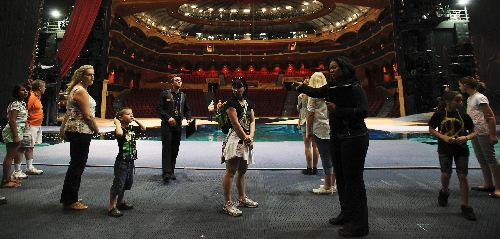‘O’ tour enhances appreciation of Cirque du Soleil’s creativity
That's gotta be one of the biggest "O(h) ... no" moments in Las Vegas show history, right there.
It's down in what they call the light tunnel of Cirque du Soleil's "O." Victor Rybushkin is sharing a view of the liquid stage from underwater, through submarine-type portals in the depths of Bellagio. The portals are made of 4-inch composition glass, he tells a small tour group. Four is a key number, because they almost settled for 2.
Then he shows the group why it's good they didn't. "They were working in the pool and somebody put a light in there," he explains. But someone went home and left the light floating underwater.
"The next day, they come in and they smell something. They can't find it, so they came down here, and they find out the light burned about 2 inches of this glass," he says, pointing to a big blister in the window.
The 2 remaining inches kept 1.5 million gallons of water from flooding the room and the electrical panels in it, and perhaps other backstage areas.
■ ■ ■
"O" lived to tell the tale, at least through the mouth of Rybushkin, who spent 11 years prowling these corridors as an original cast member.
Cirque's superstar Las Vegas title is said to be a show with no stars, but that's not true. The star is the stage itself. You can even book some quality time with it, thanks to these backstage tours on Fridays and Saturdays.
The tours are run by Entertainment Benefits Group, a third-party ticket vender operating outlets around town as Tickets & Tours. The $260 upgraded ticket -- about $88 more than the show alone, but including perks beyond the tour -- is also available for Cirque's other steady hit, "Love."
But it's "O" that serves as a constant reminder of the sky's-the-limit imagination that fueled the Strip back in 1998. The theater went up at the same time as Bellagio itself. The grand plan was a shape-shifting liquid stage with a giant, automated revolving wheel overhead; details of the actual content were fine-tuned on the fly.
"The first thing I remember when they brought us all in on one of the first days, and they turned on the lights in the pool. Nothing was ready yet," recalls Rybushkin, a competitive diver from Volgograd, Russia.
"They just kind of played with the lifts and showed us the colors in the pool. We were like, 'Wow. They could do the show with just the pool. They don't even need us.' "
That turned out to be a modest assessment from a guy who learned how to jump off a 60-foot high dive several times per week, before giving it up in 2009.
"During the show we're not just jumping from here," he says from the backstage deck where the tour group gets to peer down from the same height as a busy crew of technicians. "We run and climb the ladder first. And when you've got 60 feet of climbing and turn around and have to jump off, that makes it even more difficult."
What went through his mind before each plummet?
"I have my little prayer before I go."
■ ■ ■
Rybushkin has a safer gig now, offering tours of the place where he sat on the green room's waterproof furniture between shows, and where he met his wife, Anna, who still performs in the show as a trapeze artist who balances on her head and swings.
He trades bursts of information in his Russian accent with congenial American co-guide Trinity Price. She has never dived 60 feet, but juggles a classroom of first-graders at Matt Kelly Elementary School.
Peeking backstage can drain the magic out of many a show. Props fold into storage areas. Costumes are always more garish in normal light. And the hallways with sign-in sheets and time clocks are always ... well, as Brad Pitt quipped in "Ocean's Eleven": "They say taupe is very soothing."
But the "O" tour only seems to enhance appreciation of the nightly clockwork involving 85 performers who speak at least 16 languages.
You see their training room and the wing space of the stage where they stand under shower heads or space heaters to stay warm. You see costumes drying under giant blasters; each performer runs through at least four per show. Everyone comes on to the set dry, and everyone leaves wet.
You learn that the pieces of the stage had to be hand-drilled with thousands of holes, because nobody made one that way. "The water from the pool is not going anywhere. It's the actual stage that has so many holes, that's why the water goes through the holes. The water just stays in the pool. It doesn't drain anywhere," Rybushkin explains.
You see where scuba divers hover underwater to steer performers clear of the hydraulic lifts when the pool is full of bubbles, and the ropes they sometimes use to steer themselves.
"But everyone knows the show so perfectly that even with closed eyes, you can find where you go," Rybushkin says.
It's an amazing place to visitors, but just like home to him.
Contact reporter Mike Weatherford at mweatherford@ reviewjournal.com or 702-383-0288.






















